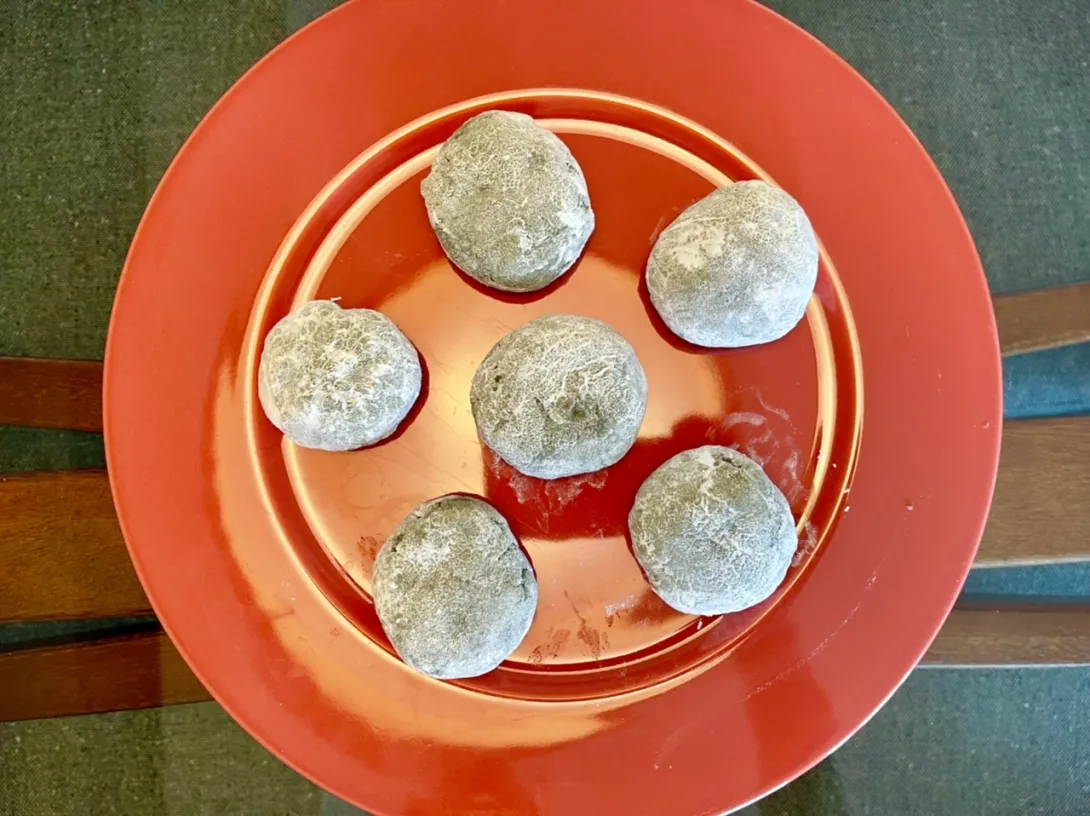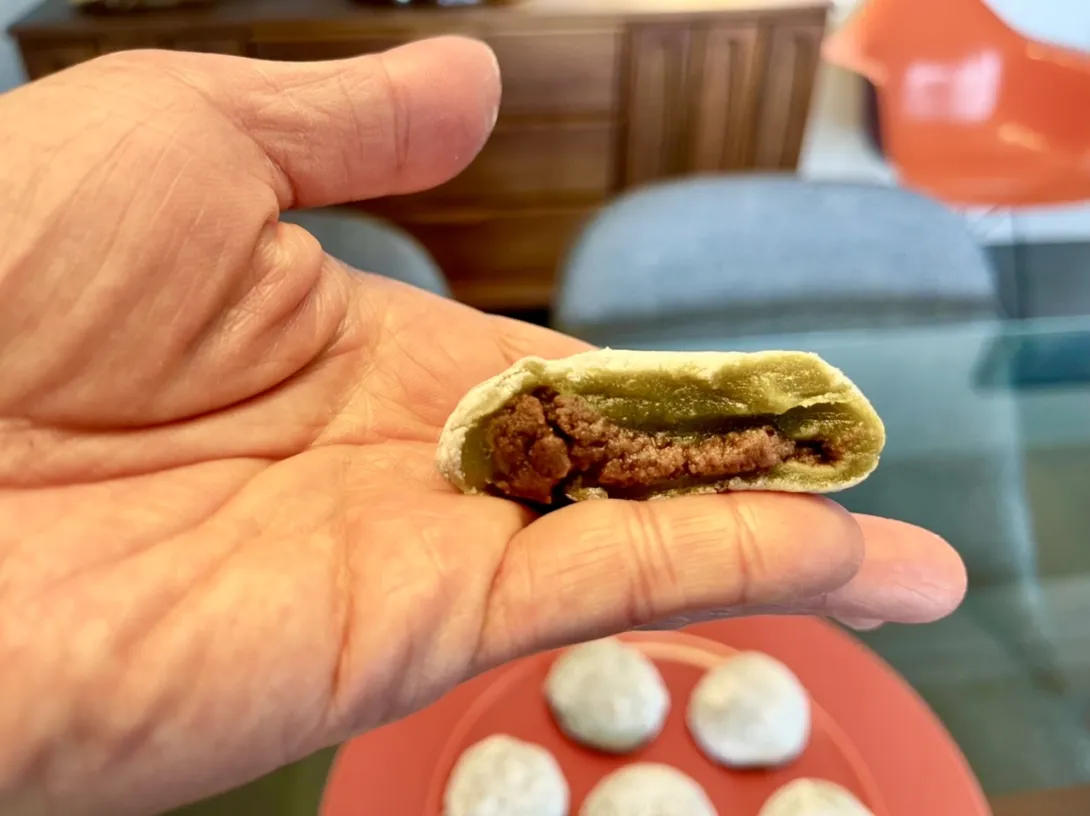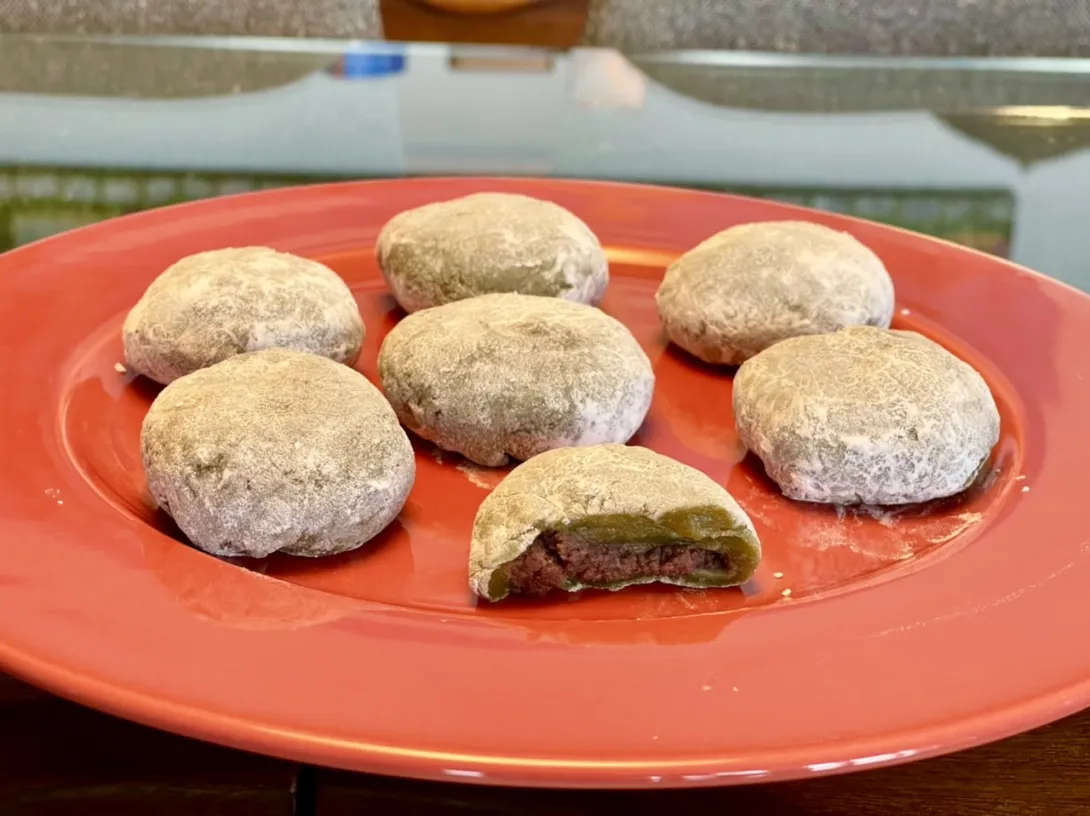I still had some anko (red bean paste) in my freezer from over a year ago and decided it was time to use it up. Since I hadn’t made mochi in so long I thought it was high time to make Daifuku Mochi again but this time with matcha. So I followed the same recipe except this time added 5 g of matcha powder. I forgot how dark the matcha becomes when water is added and would probably try only 3 g next time. The trade off might be the matcha flavour though which was perfect with the 5 g.

Makes 8 servings
Ingredients
115 g glutinous rice flour
60 g sugar
125 mL water
8 tbsp anko
1 tbsp potato starch (preferred by Japanese) or cornstarch
Optional 5 g matcha (use less the mochi was too dark green, maybe 3 g)
Instructions
- In a large bowl, mix together the 1 heaped cup of glutinous rice flour, 4 tbsp of sugar, 3-5 g of matcha powder and 1/2 cup of water until combined.
- Loosely cover with cling wrap and microwave for 1 minute.
- With the spoon, give it a quick mix, re-cover and pop back in for another minute.
- Get a spatula, and wet it in water. Pull the mochi away from the sides and fold it in until it's a rough dough ball shape. It should be sticky and pliable, with the colour turning from bright white to a more translucent cream.
- Spread the cornstarch on a clean dry surface, and pop the mochi onto it using the wet spatula. Cover it with cornstarch until it's no longer sticky, molding it into a thick and flat disc, and allow to cool for a few minutes.
- Roll 1 tbsp of red bean paste into a ball, and repeat until you have 8 balls ready to wrap with mochi.
- Grab the cooled mochi dough and cut into 8 even pieces using a knife or dough cutter (pop a bit of cornstarch on to avoid sticking).
- Coat your fingertips in the cornstarch and pick up your first piece of mochi. Flatten and shape into a disc around 10cm / 2 inches wide. Place a red bean paste ball into the centre and wrap the mochi dough around it. Pull up the edges into the centre and pinch it altogether.
- Place the mochi seam side down and repeat with the remaining dough and anko. Serve immediately or wrap in clinch wrap and freeze.
- Filling Ideas:
- Ice-cream filled mochi takes your dessert to a whole other level. Try vanilla, green tea, strawberry or black sesame!
- Sweet mung bean paste – like in Che Ba Mau
- Strawberries covered in red bean paste
- Fresh cream
- Speculoos cookie butter
- Chocolate mousse
- Peanut butter & banana
- Glutinous Rice Flour – Traditionally, if you can find Japanese sweet rice flour known as Shiratamako or Mochiko, this would be best. However, the easiest substitute is regular glutinous rice flour. We’ve found it at our local and Asian supermarkets as well as online. Look out for the see-through bag with the green writing – not the red writing (which is regular rice flour and not sticky!). Unfortunately can not substitute with all purpose flour or regular rice flour.
- Red Bean Paste – We used coarse red bean paste, but you can use the fine bean paste as well, it’s completely up to your taste. Store bought is fine – you’ll find it at your local Asian supermarket, otherwise you can also make your own from azuki beans. In a pinch, you could make a filling with sweetened kidney beans, like in Vietnamese 3 Colour Bean Dessert. Or ditch the beans, and make up your own filling!
- While cooking, look for the change of colour. You want the bright white to fade to a more translucent cream colour.
- If it’s sticking, while trying to form the mochi, add a little more cornstarch.
- Storage: Best enjoyed within 24 hours. If you can, leave it out of the fridge for the freshest taste. If you really can’t eat them all, they will keep overnight in a zip-lock plastic bag in the fridge OR you can freeze them. If freezing, coat in a little extra corn starch so they don’t stick together and pop them in a zip-lock plastic bag. Eat within the month if freezing for the best taste. To thaw, you can either leave them out on the bench for an hour or so, or heat them in 10 second bursts until thawed.


It is very difficult to cut a mochi in half, so the photo of the cut mochi makes my shaping and filling look worse than it actually was 😝
- Benito's Blog
- Log in or register to post comments
Is this the same as the Canto "ma" "chee" usually made with sesame paste filling? Man, I love Canto/Asian pastries, I hope someday I will have the time and devotion to make some of them. Nice!
Thank you Ming, I’m not sure I know the Canto Ma Chee by name. This is extremely simple to do once you have the ingredients, you should give it a try. I always love eating these and when you make them completely from scratch including the anko you can control the sugar and ensure that they’re not too sweet.
Benny
Thanks Benny for the info. I did a search of Mochi and I think it is different than the Canto version that I was thinking about. Apparently the correct spelling is Muah Chee. There are so many Canto/Asian sweet treats I love to eat as a kid that I don't know their English names, again I hope someday when I retire I will have more time to learn to make some of these pastries.
Muah Chee - Southeast Asian Recipes - Nyonya Cooking
Thanks for sharing that Ming, I’d never heard of this version mochi before but it doesn’t surprise me that non Japanese Asian cultures have their own versions of it.
Benny